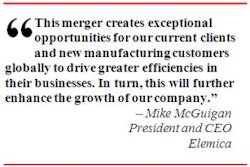
Differentiated service is about making yourself easier to do business with, anticipating the needs of your customers, having the products available to them when they want them and executing well even when customers don’t provide you good information into their demand. For example, I am tasked to travel last minute, and I am expecting that my frequented and preferred rental car provider will have a vehicle available for me when I get there. I don’t think about what its current demand is for that day, nor do I think about the individual profiles of its other renters. I simply desire, as a good customer, that it makes a car available. Not having a car for me because it lacked the proper insight into my demand is certainly understandable in this scenario. However, a differentiated service opportunity is lost, and conversely, one is gained by another rental provider.
The same holds true in the customer service operations of process industry manufacturers. Their customers all expect the material they need to be where it’s needed, when it’s needed and that the transportation assets line up accordingly. During instances when normal demand signals are absent, companies that can anticipate, plan and meet their customer expectations despite less than ideal circumstances become the winners through differentiation. Companies that lack the ability to effectively see and efficiently fulfill expectations during times when normal demand signals are absent risk watching their business go to a competitor.
Descriptive analytics paint a picture of what's happening currently, while predictive and prescriptive analytics unlock differentiated capabilities. This enables companies to shift perspective beyond the horizon and look into the future—seeing things like demand signals, market volatility or transportation issues before they happen. During a recent focus group meeting of process industry customer service leaders, the case for predictive and prescriptive analytics presented itself through a frozen-over rail yard. "Wouldn't it be great if I would have known the rail yard would freeze over,” stated one participant. “If the duration of that freeze could have been predicted, and the impact it would have had clearly outlined, I could have made some prescriptive decisions like pre-positioning truck transportation assets.”
Predictive analytics give supply chains the ability to respond to actual market conditions, predict consumer behavior and identify possible delivery constraints. In business, predictive models exploit patterns found in historical and transactional data to identify risks and opportunities. Models capture relationships among many factors to allow assessment of risk or potential associated with a particular set of conditions, guiding decision-making. Examples include using weather data to predict buying behavior or potential supply disruptions, forecasting future demand, predicting the price of fuel, and sensing transportation hub congestions and dynamically re-routing to less congestive ports.
Prescriptive analytics envision many different scenarios using intelligence gathered in real time and present an optimal solution. Prescriptive analytics help companies decide the best course of action to take given certain business objectives, requirements and constraints. They seek to find the optimal solution given a variety of choices, alternatives and influences that may affect the outcome.
Descriptive, predictive and prescriptive analytics should co-exist. One is not better than the other; they are just different. All of them are necessary to contribute to an organization’s goal of improved and more informed decision-making. With descriptive and predictive analytics helping to understand the drivers behind customer buying patterns, combined with prescriptive analytics that can determine the optimal schedule, production, inventory and supply chain network design, businesses can know how to anticipate what their customers want with high levels of service in a cost-effective way.
Next-generation business ecosystems, like a supply chain operating network, in which commerce is digitized, and flows across buyers, supplier and logistics providers, are key to enabling future-looking capabilities. As the application layer operates on the transactions and all of the data is stored in a very accessible way (and in a way that can bring in outside data feeds like economic data, weather forecasts, etc.), it can then be pulled together to deliver the type of game-changing analytics that illuminates the meaning behind the data.
Now, if only the car rental agent saw me coming. I’d already be on the road.

















